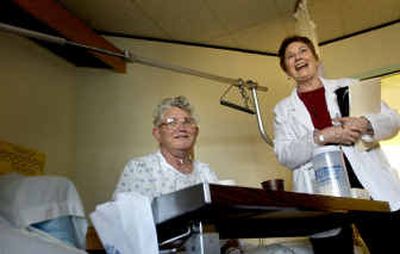Retired nurses to help fill in gaps at KMC

COEUR d’ALENE – Skill steeped in 30 years of experience tantalized Carmen Brochu.
The vice president of patient care for Kootenai Medical Center saw an abundance of potential in the retiring nurses who tearfully hugged her and their careers goodbye. Brochu knew when her time to retire arrived, her need to nurture people grasping for better health wasn’t going to disappear like an extinguished flame.
“Nursing doesn’t leave someone,” she says. “Once a nurse, you’re a nurse forever.”
So Brochu decided to tap into the retired nurse market for KMC, patients, staff nurses, doctors and retired nurses themselves. With a $25,000 grant from the Idaho Hospital Association, Brochu is launching a retired nurse volunteer corps this spring.
She envisions volunteers who can relieve some of the load on staff nurses. The pilot program will start in a general medical unit where patients are treated for such ailments as diabetes and emphysema. Retired nurses will discuss diagnoses with patients, listen to their worries, help them prepare questions for their doctors and smooth their departures from the hospital, Brochu says.
“It’s such a busy unit that the (staff) nurses sometimes feel guilty about not getting to spend more time with each patient,” says Jeanne Atha-White, unit director. “They give excellent quality care, but an extra ear to listen to patients and see what their needs are would be really neat.”
With the grant, Brochu hired Kay Kindig to coordinate the retired nurse corps. Kindig most recently directed the Panhandle Health District until she retired in 2001. But the early years of her career were devoted to nursing in Midwest hospitals. She’s talking with staff, patients, social workers and other regulars in the medical unit to understand the role retired nurses could play.
“It’s fun to be back in a hospital,” Kindig says. “I really think there’s a place for us. I transport. I feed. I make rounds and ask nurses and staff what I can do for them.”
Insurance coverage has shortened hospital stays so much that nearly all patients require a high degree of nursing care all the time. Nurses have little time anymore to sit with patients and help them digest, for example, a new diagnosis of diabetes and understand why certain life changes may be necessary, Brochu says.
“Nurses can’t practice the art as much as they like, and they get frustrated,” she says. “Nurses want to be all things to all patients.”
The nearest retired nurses program Kindig could find is in St. Louis, in a hospital where she once worked. She’s planning a visit. Kindig will start KMC’s program with about a dozen volunteers, most likely in April. Retired nurses will wear white coats and badges identifying them. They’ll work a few hours a week on the day shift.
All KMC’s nurse corps needs now are volunteers. They expect no trouble finding them.
“The retired nurses I’ve talked to say, ‘Sign me up,’ ” Kindig says. “Every RN I’ve talked to is interested.”